The Liberation of Bergen-BelsenPrevious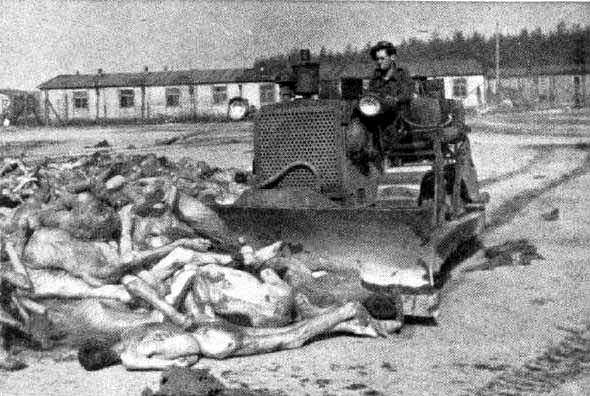 Mike Lewis, a Jewish soldier in the British Army, filmed the bulldozers, driven by British soldiers, as they shoved the emaciated bodies towards the mass graves. This documentary film is still shown today at the Memorial Site. In the film, Mike Lewis said that he took a turn driving the bulldozer himself, while another soldier held the camera. The SS men and women were forced, at gunpoint, to carry the bodies with their bare hands to the mass graves. 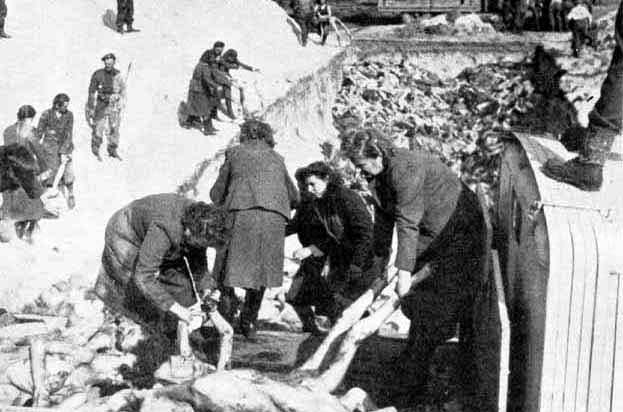 One of the witnesses to the liberation of Bergen-Belsen by British soldiers on April 15, 1945 was Iolo Lewis, a 20-year-old soldier from Wales. He recalled that, as he arrived at Belsen, Commandant Kramer and his assistant, Irma Grese, were standing at the gates to greet them. Most of the SS men, who were the guards in the camp, had escaped before the British arrived. Commandant Josef Kramer and 80 of the SS men and women had volunteered to remain in the camp to carry out their duties. He said that he counted 13,000 unburied corpses at the time of the liberation, and that the haunting memory never left him, particularly the pearly colour of the piled-up bodies, small, like the bodies of children. Lewis said that his comrades pushed cigarettes and sweets through the wire to the inmates who fell on them so ferociously that some were left dead on the ground, torn to pieces in the sordid scramble. The Hungarian Wehrmacht soldiers, who had been assigned to guard the camp during the transition, shot into the mob and killed numerous people. Lt. Lawrence Alsen, a British soldiers who was at the camp on the day of the liberation, told his son Niall after the war that "In some respects, the Hungarians were worse than the Germans." According to Eberhard Kolb, who wrote a book about Bergen-Belsen, there were "ferocious scenes" on the day of the liberation and the following night. Kolb wrote that "A succession of detested Kapos were also lynched in this period." Some of the prisoners who had arrived on the 8th of April 1945 had taken the opportunity to plunder the kitchen and food stocks. The British reported later that there was no food in the camp when they arrived. On April 17, 1945, two days after the first British soldiers arrived, British Medical units were at the scene. The first thing they did was to set up a hospital area in the barracks of the German Army training camp nearby. Also on that date, the British arrested the entire personnel of the SS Commandant's office, the 50 men and 30 women who had voluntarily stayed behind to help the British manage the catastrophe. A Jewish Camp Committee was organized by the survivors, under the leadership of Josef Rosensaft. On April 18, 1945, the burial of the dead began. The staff members, who were now prisoners of the British, were ordered to do the work of burying the bodies. The British deliberately forced the SS staff to use only their bare hands to handle the corpses of prisoners who had died of contagious diseases. In the documentary film which was shown in the newsreels in theaters around the world, a British officer said that the Germans were being punished by not allowing them to use gloves to handle the bodies. According to Eberhard Kolb, 20 out of the 80 guards, who were forced to handle diseased bodies without wearing protective gear, died later and the majority of the deaths were from typhus. On April 21, 1945, the evacuation of the camp began. The prisoners were first deloused and then moved into the barracks of the German Army Training Center next to the camp. Two days later, 6 detachments of the Red Cross arrived to help. The epidemics had yet to be brought under control and 400 to 500 prisoners were still dying each day, but by April 28, the German guards had caught up with the burial of the bodies and the mass graves were completed. German civilians from the towns of Bergen and Belsen were brought to the camp on April 25, 1945. Below is an excerpt from the speech of the British officer to the elderly Germans before taking them on a tour of the camp. (Quoted from "The World Must Know" by Michael Berenbaum) What you will see here is the final and utter condemnation of the Nazi party. It justifies every measure the United Nations will take to exterminate that party. What you will see here is such a disgrace to the German people that their names must be erased from the list of civilized nations [...] It is your lot to begin the hard task of restoring the name of the German people [...] But this cannot be done until you have reared a new generation amongst whom it is impossible to find people prepared to commit such crimes; until you have reared a new generation possessing the instinctive good will to prevent a repetition of such horrible cruelties. We will now begin our tour. Prisoners continued to die, in spite of the medical treatment provided by the Red Cross and the British Army. Nine thousand died in the first two weeks after the British arrived, and another 4000 died in May. The bodies were thrown into unmarked mass graves, even though the identities of these prisoners were known. Today none of the mass graves at Bergen-Belsen has a stone with the names of those who are buried there. 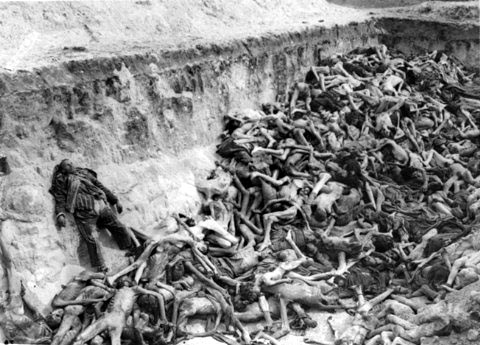  A British documentary film shows healthy Jewish liberated prisoners lined up, screaming at the top of their lungs at the SS men and women as they go about their macabre task. On the day that the German civilians were brought to the camp, the Jewish women in the camp screamed at them as the Germans were forced to watch the loading of the corpses. Later the Bergen residents were forced to evacuate their homes and former Jewish prisoners moved in; the Germans were ordered to leave all their silverware, china and linens for the use of the former prisoners. 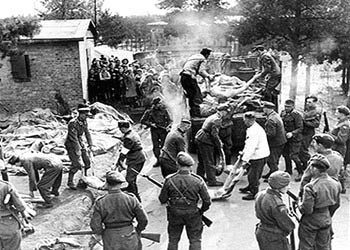 On April 29, the day after the German guards completed their gruesome task of 10 days of burying the 10,000 decomposed bodies with their bare hands, they were taken to the prison in the city of Celle, which is 16 kilometers northwest of the camp. Also on that day, April 29, 1945, American soldiers entered the Dachau concentration camp and discovered bodies of prisoners who had died of typhus. The next day, 97 medical students arrived in Bergen-Belsen to help with the sick prisoners, and on May 4th, more British medical units arrived. On that same day, May 4, 1945, part of the German Army surrendered to the British in the area near the camp. By May 19, 1945, all the former prisoners had been evacuated to the nearby Army barracks and on May 21, 1945, the last hut at the Bergen-Belsen camp was burned to the ground. The horror that was Bergen-Belsen had been completely wiped off the face of the earth. Today the former camp is a landscaped park with heather, which blooms in August, covering the mass graves. Most of the visitors to the Memorial Site are German students who come on tour buses. 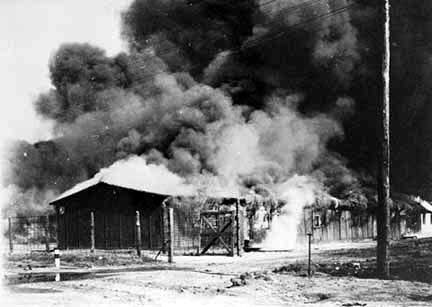 In July 1945, 6,000 survivors were taken to Sweden to recover from their ordeal at Bergen-Belsen. Some of them stayed there as long as three years to recover from typhus. The former prisoners at Bergen-Belsen who were willing to return to their home countries were released from the camp and had to find their way home by themselves. Along the way, they helped themselves to whatever they wanted, looting and stealing. Clara L. was a Hungarian Jew who was sent on a transport to Auschwitz-Birkenau in 1944, but was then evacuated to Bergen-Belsen in January 1945 after the Nazis were forced to abandon the Auschwitz concentration camp to the Soviet Army. She told the following story to the editors of a book called "Witness, Voices from the Holocaust": You see, when Bergen-Belsen was liberated these people were let loose. So we were wandering. We were wandering from one place to another. And there were warehouses. We came to a building, and we walked in, and I still see rows and rows and shelves of handbags, ladies' handbags. As we were walking over there to reach those shelves, I sort of stepped on something. And I said to my friend, "Look! There's a body!" You see, somebody, one of these inmates who wandered to these warehouses and dropped dead from exhaustion or something. And she says, "What do you want me to do about it?" I said, "Let's carry it out." She said, "Are you crazy? You can't carry that out." and she took a few packages of these linens and dropped it on (the body). And then we went to the shelves, and she wanted a handbag. And I wasn't in the mood anymore for the handbag. She pulled out one handbag. It was an alligator handbag. She says, "Take this one." I took it, and she took another one, and we walked out. And I remember, as we left the place, I just threw back the bag. I said, "I don't want it." - and walked away. And this only came back. I never thought about it. The Zionists at Bergen-Belsen, who wanted to go to Palestine, were housed at the Germany Army Training Center to wait for permission from the British who were in control of Palestine at that time. The DP camp at the Army Base was the largest one in Europe. It remained open until 1950, after the last Jews had emigrated to Palestine or some other country. Hungarian Jews at Bergen-BelsenPreviousBack to Bergen-Belsen indexHome |